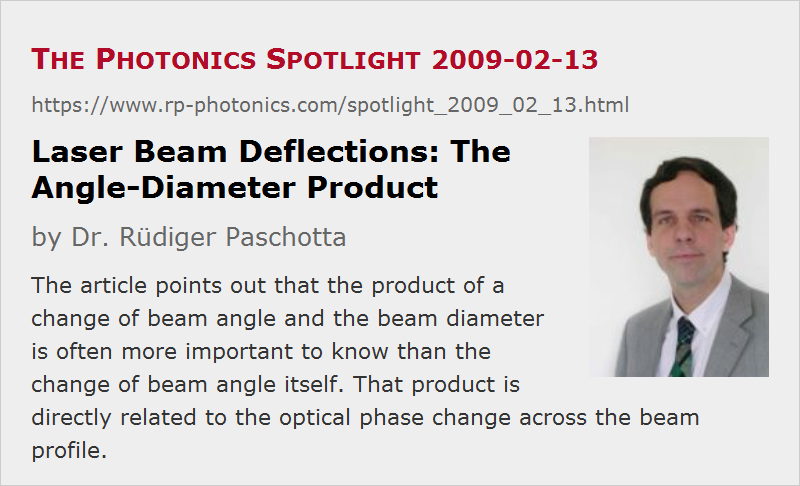Laser Beam Deflections: The Angle–Diameter Product
Posted on 2009-02-13 as a part of the Photonics Spotlight (available as e-mail newsletter!)
Permanent link: https://www.rp-photonics.com/spotlight_2009_02_13.html
Author: Dr. Rüdiger Paschotta, RP Photonics Consulting GmbH
Abstract: The article points out that the product of a change of beam angle and the beam diameter is often more important to know than the change of beam angle itself. That product is directly related to the optical phase change across the beam profile.
Ref.: encyclopedia articles on laser beams, beam radius, beam divergence, alignment sensitivity of optical resonators

When a laser beam is deflected, one may consider the angular change of propagation direction, but it turns out that this quantity alone is not really what counts.
Think about a laser scanner, for example, as used for some scanning laser projector display or in a printing application. After leaving the scanner (containing e.g. a vibrating mirror or a rotating polygon), the beam may be sent through some optics before going to a projection screen, a film or whatever other object. These optics may increase or decrease the angular range of the scan. Does that mean that the angular scan range of a scanner doesn't matter, as we can always “amplify” it with suitable optics?
No, it doesn't. A telescope can increase the angular range, but it will then also increase the beam divergence and decrease the beam radius. The ratio of angular range and divergence angle remains constant. This means that if the original angular range of the scanner is suitable only for a limited number of pixels, this will not change in whatever optics we may apply. In other words, the angle–diameter product (θ−D product) of the scanner is what limits us. For a high pixel number, this product has to be large. If some scanner can accept only small-diameter laser beams, its scan angle needs to be large in order to support some pixel number.
It is also instructive to consider deflection in terms of optical phase changes. If a beam with diameter D is deflected by an angle θ, this implies a difference in phase shift of k θ D, with k = 2π / λ. So we see that the angle–diameter product is directly related to this phase shift. And a larger beam is in a way more “sensitive” to angular changes: it picks up a larger phase difference between its extremes.
A similar aspect occurs in the context of beam pointing fluctuations. People sometimes simply specify some r.m.s. angular range of the output beam of a laser. This doesn't say much, however, as long as the output beam radius is not known: with some additional optics, you may always convert some collimated beam into another collimated beam with larger radius, exhibiting smaller angular fluctuations. What is preserved – and what is relevant to know – is the angle–diameter product.
By the way, knowing about these issues, we are less surprised about the fact that laser resonators with large effective mode area generally exhibit a higher alignment sensitivity.
This article is a posting of the Photonics Spotlight, authored by Dr. Rüdiger Paschotta. You may link to this page and cite it, because its location is permanent. See also the RP Photonics Encyclopedia.
Note that you can also receive the articles in the form of a newsletter or with an RSS feed.
Questions and Comments from Users
Here you can submit questions and comments. As far as they get accepted by the author, they will appear above this paragraph together with the author’s answer. The author will decide on acceptance based on certain criteria. Essentially, the issue must be of sufficiently broad interest.
Please do not enter personal data here; we would otherwise delete it soon. (See also our privacy declaration.) If you wish to receive personal feedback or consultancy from the author, please contact him e.g. via e-mail.
By submitting the information, you give your consent to the potential publication of your inputs on our website according to our rules. (If you later retract your consent, we will delete those inputs.) As your inputs are first reviewed by the author, they may be published with some delay.
 |




If you like this page, please share the link with your friends and colleagues, e.g. via social media:
These sharing buttons are implemented in a privacy-friendly way!